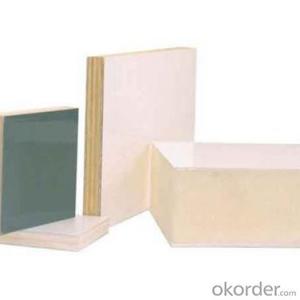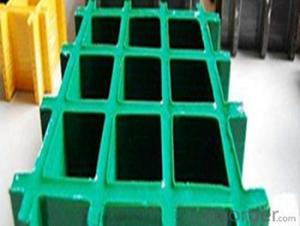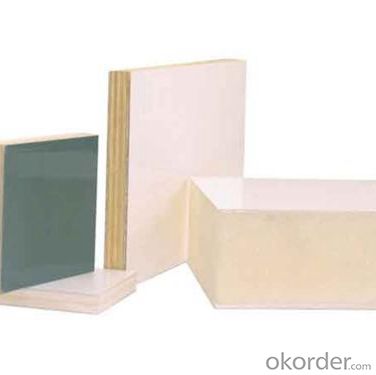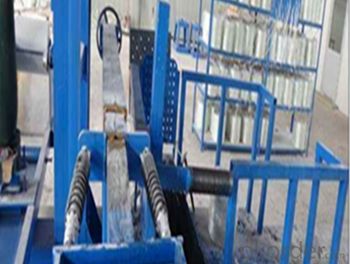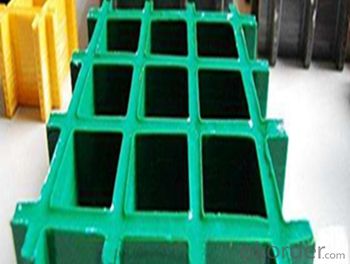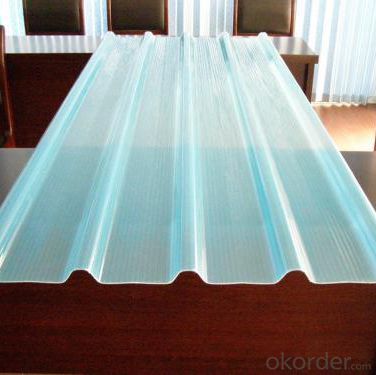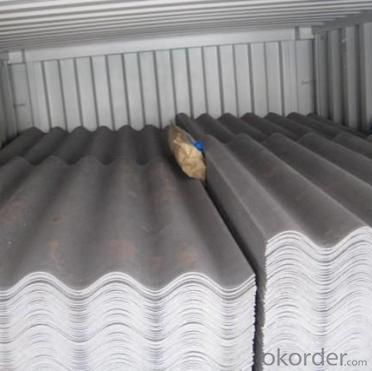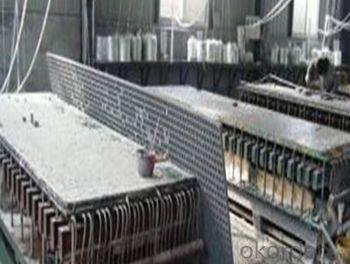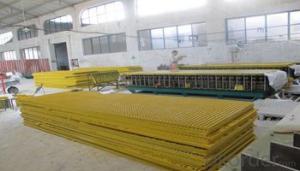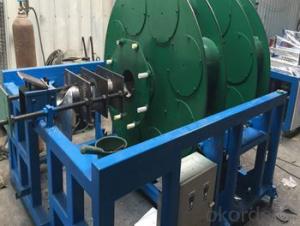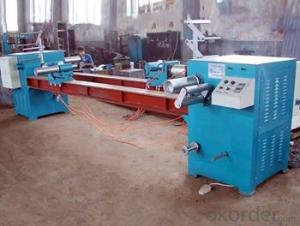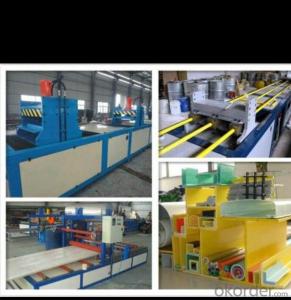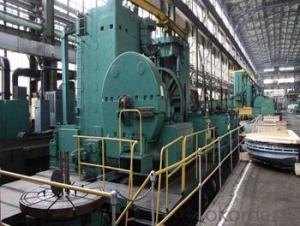FRP Pultrusion Profiles - Lightweight, High Strength FRP Pultruded Grating with Good Quality
- Loading Port:
- Tianjin
- Payment Terms:
- TT OR LC
- Min Order Qty:
- 20000 m.t.
- Supply Capability:
- 500000 m.t./month
OKorder Service Pledge
OKorder Financial Service
You Might Also Like
Specification
PRODUCT DESCRIPTION
Pultruded grating is made by a particular assembly process, which using “I” shape as its main load-bearing and special rod to go through the bearing bar. Pultruded grating include the standard grating and the custom grating, the custom grating can be designed to meet customer’s requirement or special using condition by changing the shape, size and space of the bearing bars, the surface can be covered with lozenge panel, grit panel, or added the anti-slippery sand directly.
FRP pultruded grating has the most characteristics of molded grating, but it has its distinct advantages, it has very high fiberglass content in the loading direction, so it has very high load capability, it has more superiority when used at wide span, so that the basic support will be decreased and the project cost will be reduced accordingly.
SPECIFICATION
The standard space between two crossbars is 6 inch or 12 inch.
Thickness (mm) | Bar width (mm) | Open space (mm) | Open rate (%) | Approx weight (kg/m |
25.4 | 15.2 | 22.8 | 60 | 13.2 |
25.4 | 15.2 | 15.2 | 50 | 15.9 |
25.4 | 15.2 | 10.1 | 40 | 18.5 |
25.4 | 40 | 10.8 | 21 | 14.5 |
38.1 | 15.2 | 22.8 | 60 | 15.8 |
38.1 | 15.2 | 15.2 | 50 | 19.1 |
38.1 | 15.2 | 10.1 | 40 | 22.4 |
50.8 | 25.4 | 25.4 | 50 | 16.6 |
50.8 | 25.4 | 12.7 | 33 | 21.1 |
CHOICE FOR PULTRUDED GRATING
Resin: GP resin, ISO resin, VE resin, Phenol resin
Color choice: Yellow, gray, green, custom color
Surface choice: Groove surface, grit surface, lozenge cover surface
FEATURES
a. Anti-corrosion and anti-rust
b. Light weight and high strength
c. Anti-flammable
d. Anti- fatigue
e. Safe and anti-slippery
f. Anti-ageing
g. Easy of maintenance
h. Excellent electromagnetism property
i. Good economic benefit
FIELDS SERVED
Sewage treatment,
water supply and drainage,
chemical industry,
oil industry,
power engineering,
pulp and paper,
construction engineering,
spinning, marine engineering.
APPLICATION
Operation terrace,
stair walkway,
ground floor,
trench cover,
sidewalk,
foot bridge,
equipment safety fence,
scaffold.
COMPANT DESCRIPTION
CNBM,China National Building Materials Group is a state-owned enterprise in charge of administrative affairs in china building materials industry. Established in 1984, CNBM is a large group corporation of building materials with total assets of 25 billion RMB and a total staff of 30,000.CNBM now owns 200 subordinating firms of solely owned and joint-venture companies.
CNBM International Corporation is one subsidiary of CNBM, we focus on offering good-quality products,professional service and complete solution to our customers. Strong delivery capacity, advanced technology& management, strong financing capability and excellent after-sale service are our advantages in sharing international market.
FAQ
Q1.What's your sample policy?
A:We can supply the sample if we have ready parts in stock, but the customers have to pay the courier cost.
Q2.Can you produce according to the samples?
A: Yes, we can produce or modify the products according to your request.
Q3.How do you deliver the goods to my country?
A:We can provide international express, such as DHL, EMS, UPS, FedEx, etc. We select air freight and sea freight upon your requests. Quotations if without mentioning the shipping costs are shipping fee excluded.
Q4.How much does it cost to ship to my country?
A:When you goanna to place an order, please contact us, because different country has different freight.
Q5.How to get the catalogue?
A:please contact us and tell us what you are looking for.
We will try our best to meet customers' demands. Welcome you come here to visit us. We sincerely welcome partners around the world to establish business cooperation with us on the basis of mutual trust, benefit and development.
PICTURES
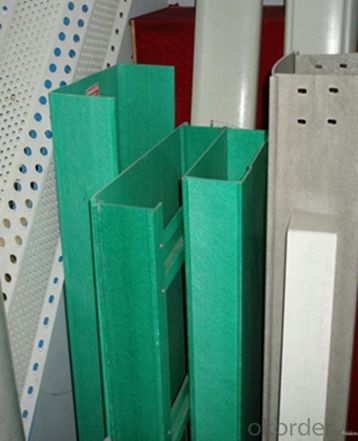
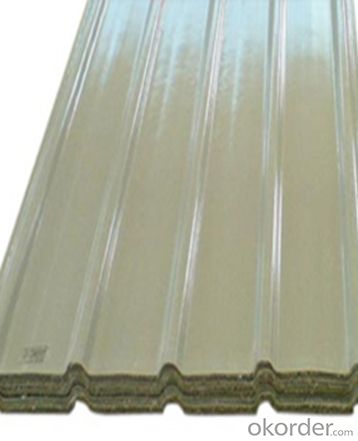
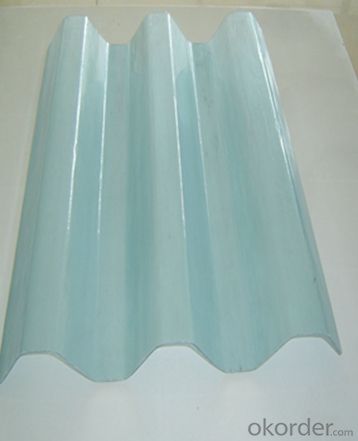
- Q: Can FRP pultrusion profiles be used in the automotive industry?
- Yes, FRP (Fiber Reinforced Plastic) pultrusion profiles can definitely be used in the automotive industry. FRP pultrusion profiles offer several advantages that make them suitable for automotive applications. Firstly, FRP pultrusion profiles are lightweight, which is a crucial factor in the automotive industry as it helps in improving fuel efficiency and reducing overall vehicle weight. Lighter vehicles have lower energy consumption and emissions, making them more environmentally friendly. Secondly, FRP pultrusion profiles have excellent strength-to-weight ratio. This means they can provide high strength and stiffness while being lightweight. This property makes them ideal for structural components in automobiles, such as chassis, body panels, and support structures. Furthermore, FRP pultrusion profiles are highly corrosion-resistant, which is a significant advantage in automotive applications. Vehicles are often exposed to harsh environmental conditions, including moisture, salt, and chemicals. The corrosion resistance of FRP helps in ensuring the longevity and durability of automotive components, even in challenging environments. Additionally, FRP pultrusion profiles have good impact resistance, which is crucial for automotive safety. They can absorb and dissipate energy during impacts, reducing the risk of injury in case of accidents. Moreover, FRP pultrusion profiles can be customized and engineered to meet specific design requirements, allowing for versatility in automotive applications. They can be designed to have specific mechanical properties, shapes, and sizes, making them suitable for various automotive components. Overall, the lightweight, high strength, corrosion resistance, impact resistance, and customization options make FRP pultrusion profiles an excellent choice for the automotive industry. They offer numerous benefits, including improved fuel efficiency, enhanced safety, and prolonged component life, making them a viable alternative to traditional materials in automotive applications.
- Q: Can FRP pultrusion profiles be used in the construction of railway sleepers?
- Yes, FRP (Fiber Reinforced Polymer) pultrusion profiles can be used in the construction of railway sleepers. FRP pultrusion profiles offer several advantages that make them suitable for this application. Firstly, FRP pultrusion profiles are lightweight yet strong, making them ideal for railway sleepers. They have high strength-to-weight ratios and can withstand heavy loads, making them a reliable choice for supporting the weight of trains. Additionally, the lightweight nature of FRP profiles makes them easier to transport and install, reducing construction time and costs. Secondly, FRP pultrusion profiles are highly resistant to corrosion, which is a crucial factor for railway sleepers. Traditional materials such as wood or steel are susceptible to corrosion when exposed to moisture and chemicals. FRP profiles, on the other hand, are non-corrosive and do not require regular maintenance or replacement due to rust or decay. Furthermore, FRP pultrusion profiles offer excellent durability and longevity. They are resistant to UV radiation, extreme temperatures, and chemicals, ensuring a longer lifespan compared to traditional materials. This reduces the need for frequent replacements, resulting in lower maintenance and lifecycle costs. Moreover, FRP pultrusion profiles can be customized to meet specific design requirements. They can be manufactured in various shapes and sizes to fit different railway sleeper designs, offering flexibility in construction. Additionally, they can be made in different colors, allowing for aesthetic customization. Lastly, FRP pultrusion profiles offer excellent electrical insulation properties. This is crucial for railway sleepers, as they need to provide insulation between the train tracks and the ground to prevent electrical interference and ensure safe operation. In conclusion, FRP pultrusion profiles are a suitable choice for the construction of railway sleepers due to their lightweight, high strength, corrosion resistance, durability, customization options, and electrical insulation properties.
- Q: What are the typical dimensions and sizes of FRP pultrusion profiles?
- The typical dimensions and sizes of FRP pultrusion profiles vary depending on the specific application and manufacturer. However, common dimensions range from small profiles measuring around 5mm to larger profiles exceeding 100mm in width or diameter. Lengths can also vary, typically ranging from a few meters to several meters.
- Q: Can FRP pultrusion profiles be used in the telecommunications and data communication industry?
- Indeed, the telecommunications and data communication industry can utilize FRP (Fiber Reinforced Plastic) pultrusion profiles. These profiles possess numerous advantages that render them appropriate for incorporation in this particular sector. First and foremost, FRP pultrusion profiles exhibit exceptional electrical insulation properties, rendering them perfect for applications in the telecommunications and data communication industry where minimizing electrical conductivity is imperative. FRP profiles do not conduct electricity, thereby ensuring the absence of interference or grounding issues that could potentially disrupt data transmission. Secondly, FRP pultrusion profiles are both lightweight and robust, resulting in a high strength-to-weight ratio. This characteristic makes them well-suited for the construction of communication towers, antenna supports, and satellite dish mountings. In these applications, the profiles must withstand environmental stresses such as wind loads. Moreover, FRP profiles exhibit outstanding corrosion resistance, a crucial attribute in the telecommunications and data communication industry where equipment is frequently exposed to harsh outdoor environments. Unlike traditional materials like steel or aluminum, FRP profiles do not rust or corrode, thereby guaranteeing the longevity and reliability of the infrastructure. Furthermore, FRP profiles can be easily customized and manufactured in various shapes and sizes to meet the precise requirements of telecommunications and data communication applications. This flexibility enables the design and construction of intricate structures capable of accommodating different equipment and technologies. In summary, FRP pultrusion profiles provide a multitude of advantages that render them highly suitable for application in the telecommunications and data communication industry. Their electrical insulation properties, lightweight yet strong nature, corrosion resistance, and design flexibility make them a dependable choice for supporting infrastructure in this sector.
- Q: How do FRP pultrusion profiles handle torsion loads?
- FRP pultrusion profiles are known for their excellent mechanical properties and high strength-to-weight ratio, making them an ideal choice for handling torsion loads. When subjected to torsion, these profiles are designed to withstand twisting forces and maintain their structural integrity. The key to their ability to handle torsion loads lies in their construction. FRP pultrusion profiles are manufactured by pulling reinforcing fibers, such as fiberglass, through a resin bath and then through a heated die. This process aligns the fibers in the direction of the load, providing exceptional strength and stiffness. In the case of torsion loads, the aligned fibers in the profile's cross-section resist the twisting force by distributing it along the length of the profile. This distribution of force helps prevent localized stress concentrations, reducing the risk of deformation or failure. Additionally, the resin matrix surrounding the fibers acts as a binding agent, holding the fibers together and providing protection against environmental factors such as moisture, chemicals, and UV radiation. This ensures the long-term durability and stability of the profile under torsion loads. Furthermore, FRP pultrusion profiles can be designed with specific cross-sectional shapes and dimensions to enhance their torsional strength. By optimizing the geometric configuration, such as increasing the wall thickness or adding reinforcing ribs, the profiles can be further strengthened to meet the desired torsion load requirements. Overall, FRP pultrusion profiles excel in handling torsion loads due to their inherent properties, manufacturing process, and design flexibility. Their ability to resist twisting forces, coupled with their lightweight nature, makes them a reliable and cost-effective choice for various applications, including construction, infrastructure, aerospace, and automotive industries.
- Q: Can FRP pultrusion profiles be used in the construction of solar panel frames?
- Yes, FRP (Fiber Reinforced Polymer) pultrusion profiles can be used in the construction of solar panel frames. FRP pultrusion profiles are lightweight, strong, and resistant to corrosion, making them an ideal material choice for solar panel frames. The durability and high strength-to-weight ratio of FRP pultrusion profiles ensure that the frames can withstand various weather conditions and long-term exposure to sunlight. Additionally, FRP pultrusion profiles can be easily customized to meet specific design requirements, allowing for flexibility in the construction of solar panel frames. Overall, the use of FRP pultrusion profiles in solar panel frame construction offers numerous advantages, making it a suitable choice for the solar energy industry.
- Q: Can FRP pultrusion profiles be customized or tailored to specific project requirements?
- Yes, FRP pultrusion profiles can be customized or tailored to specific project requirements. They can be designed and manufactured in various shapes, sizes, and configurations to meet specific project needs, such as load-bearing capacity, stiffness, corrosion resistance, and thermal properties. Customization options also include adding features like brackets, holes, or reinforcements to ensure the profiles are optimized for the intended application.
- Q: What raw materials do FRP pultrusion require?
- Resin: commonly used unsaturated polyester resin, epoxy resin, vinyl ester resin, phenolic resin;
- Q: Are FRP pultrusion profiles resistant to humidity or moisture?
- Yes, FRP pultrusion profiles are highly resistant to humidity or moisture due to their non-porous nature and the use of corrosion-resistant materials.
- Q: Can FRP pultrusion profiles be used in aerospace applications?
- Yes, FRP (Fiber Reinforced Polymer) pultrusion profiles can be used in aerospace applications. These profiles offer a combination of strength, lightweight, and corrosion resistance, making them suitable for various aerospace components such as structural supports, fairings, and interior panels. Additionally, FRP pultrusion profiles have high fatigue resistance and can withstand extreme temperatures, enhancing their suitability for aerospace use.
Send your message to us
FRP Pultrusion Profiles - Lightweight, High Strength FRP Pultruded Grating with Good Quality
- Loading Port:
- Tianjin
- Payment Terms:
- TT OR LC
- Min Order Qty:
- 20000 m.t.
- Supply Capability:
- 500000 m.t./month
OKorder Service Pledge
OKorder Financial Service
Similar products
Hot products
Hot Searches
Related keywords
